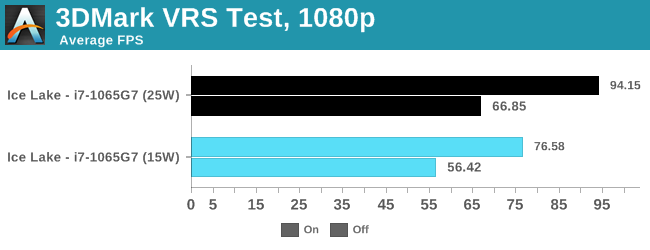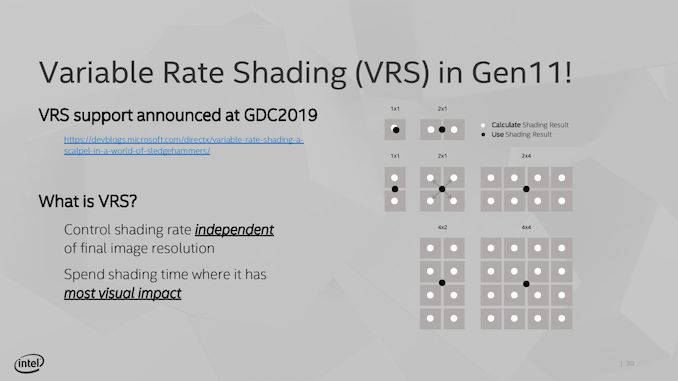The Ice Lake Benchmark Preview: Inside Intel's 10nm
by Dr. Ian Cutress on August 1, 2019 9:00 AM EST- Posted in
- CPUs
- Intel
- GPUs
- 10nm
- Core
- Ice Lake
- Cannon Lake
- Sunny Cove
- 10th Gen Core
Gaming Results (15W and 25W)
One of the biggest changes to the Ice Lake design is in the integrated graphics – Intel is now giving more focus and more die area to graphics, something it has arguably been neglecting for several years now. With Ice Lake, we move to a Gen11 graphics architecture, which is almost like the previous Gen9.5 but now with added support for variable rate shading (VRS), moving from 24 EUs to 64 EUs, and memory support up from LPDDR3-2133 to LPDDR4X-3733.


World of Tanks is a very CPU driven benchmark, and having the extra frequency of the 25W processor does help here. We're getting a sizeable uplift from Whiskey Lake, due to the extra EUs and memory frequency.


Our Final Fantasy test seemed to regress in 25W mode, although still within the noise. This test is still GPU bound, so adding the extra TDP to the CPU didn't actually help much. However, comparing to the Whiskey Lake integrated graphics, we've got over a 2x speedup.


Similarly with Civilization, with what is normally our 'IGP' settings, we are still GPU limited here.
One of Intel's newest features is Variable Rate Shading.
If developers add the option, soon to be an easy checkbox in Unity and Unreal, the game can decide to control the rate at which it shades pixels, from calculating every pixel down using one result across a 4x4 grid, to save compute power. Currently the only way to test this is with the 3DMark functional demo.

The new VRS test in 3DMark is designed as a feature test to show the potential uplift effect from enabling variable rate shading within a game. In both 15W and 25W modes, the data saw a good uplift, and we seemed to get more out of the 25W mode than the 15W mode.














261 Comments
View All Comments
HStewart - Thursday, August 1, 2019 - link
Keep in mind AMD 7nm die does not mean higher transistors than Intel 10nm Because under different process companies. Lower number does not always mean betterzodiacfml - Friday, August 2, 2019 - link
I'm saying that Intel's die/wafer is probably larger than AMD's 7nm die considering the decent IGP that comes with the Intel chip. I realized my comment is pointless though considering AMD has not released a 7nm APU yet for a proper comparison.Phynaz - Thursday, August 1, 2019 - link
Yawn, another AMD troll that doesn’t know what a laptop is.Tyler_Durden_83 - Thursday, August 1, 2019 - link
My God these new ICL parts are, considering the wait, even more yawn than the 2080 super was...shabby - Thursday, August 1, 2019 - link
I think it would be smart to wait for retail laptops to hit the market before drawing a conclusion on ice lake, who knows what tweaks this ringer laptop from intel has.GreenReaper - Friday, August 2, 2019 - link
Having the fan running on full all the time is kinda cheating to start with. You wouldn't actually want that as a laptop experience. However, the laptops were actually designed for OS testing (where you typically want to avoid throttling to have clean data) so I can cut them a bit of slack there.masimilianzo - Thursday, August 1, 2019 - link
I am sorry it was not clear to me if the 3.9GHz turbo frequency was kept for all the duration of the Spec2k6/2k17 benchmark runs.prophet001 - Thursday, August 1, 2019 - link
Any idea on when desktop SKUs will be coming?Eris_Floralia - Thursday, August 1, 2019 - link
If you are talking about traditional socketed DT parts, the answer is never.DanNeely - Thursday, August 1, 2019 - link
There aren't any 10nm desktop parts on leaked roadmaps out to 2021.If you trust the leaks from Semi-Accurate there probably never will. Of the 4 planned 10nm fabs one was upgraded to 14nm (from an even older process); one or two others are getting 7nm tooling. That leaves 10nm capacity at 25-50% of originally planned numbers meaning they're never going to make 10nm in high volume which in turn means that large chunks of the market will probably go directly to 7 in a few years after lingering at 14.